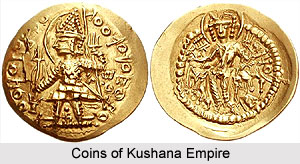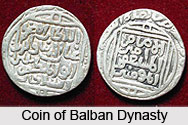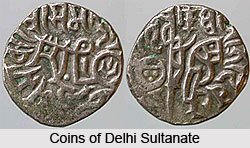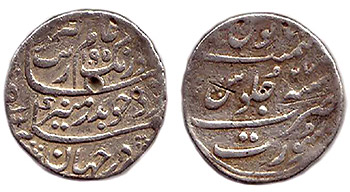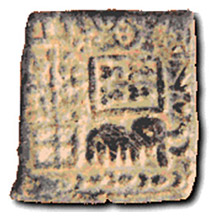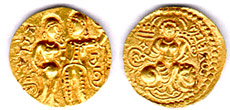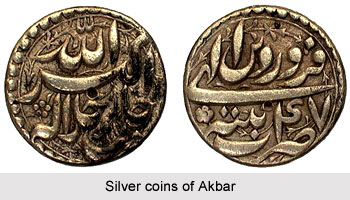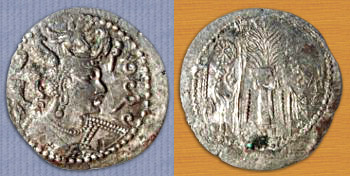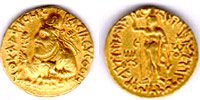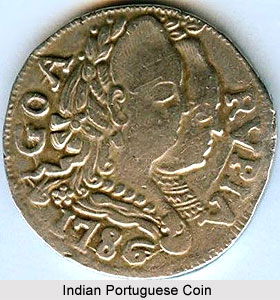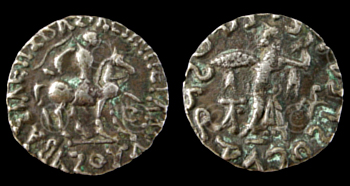 A new phase in Indian history commenced with the coming of Alexander the Great to India in 326 B.C. He crossed the Indus, marched to Taxila and then advanced to Hydespes (Jhelum), where he was strongly opposed by Puru (Porus). The final victory was achieved by Alexander and the victory was commemorated by silver `decadrachms` and `tetradrachms`. These coins were found in Babylonia. The coins manifest a figure which was identified as Alexander, in the form of the Greek god Zeus, was shown on one side. On the other side of the coins were the goddess of victory, Nike was crowning him. Another scene was depicted that defined a horseman with a lance at rest charging upon a retreating elephant, on whose back were two men turning round to face their pursuer.
A new phase in Indian history commenced with the coming of Alexander the Great to India in 326 B.C. He crossed the Indus, marched to Taxila and then advanced to Hydespes (Jhelum), where he was strongly opposed by Puru (Porus). The final victory was achieved by Alexander and the victory was commemorated by silver `decadrachms` and `tetradrachms`. These coins were found in Babylonia. The coins manifest a figure which was identified as Alexander, in the form of the Greek god Zeus, was shown on one side. On the other side of the coins were the goddess of victory, Nike was crowning him. Another scene was depicted that defined a horseman with a lance at rest charging upon a retreating elephant, on whose back were two men turning round to face their pursuer.
The coins of foreign invaders include the coins that were issued during the time of Greek, Bactrian and Sakas. Apart from these invaders, several other invaders came to India and issued coins for their trading purpose. After the death of Alexander, the true association of foreign coinage with India took place. During this time the far flung territories that he had conquered were divided amongst the powerful officers of his army. A Greek kingdom was established in Syria under Seleucus in this period. The Greek rulers extended their territory with the progression of time. Later, gold coins were found of this period that proves issuing of gold coins during this time. These gold coins were issued by Diodotus (Seleucid satrap of Bactria), Eucratides (one of the most important Greco-Bactrian kings) and Euthydemus. But these coins were confined to Bactria and were never issued in India. According to the basis of their types, a few legendless gold coins were attributed to Menander. During this period, most of the coins were issued in silver and copper. A few pieces of Pantaleon and Agathocles were found in nickel and they are considered to be the earliest coins in the world issued in this metal. The kings of Bactria adhered strictly to the monetary system of Athens, which had been adopted by the Greek ruler Alexander and his successors in Syria. The silver Indo-Bactrian coins were also issued with exception of certain square coins. The coins were all round and struck to Persian standard. The copper coins were issued in umpteen numbers and believed to have been issued on the standards of the local copper coins of Taxila.
The coins of Indo-Bactrian rulers issued coins by die-striking technique which followed the Greek pattern. They give a new form to the Indian coinage by placing portraits of the king on the obverse side of the coin. A form of coin was common during this period which was the helmeted head or bust. Apart from these, some coins issued during this time manifest the king wearing an elephant scalp, sometimes to commemorate the kings, the heads of the kings were portrayed on the coins. The portraits on the coins were realistic and boldly drawn and represent clearly the facial features of the early foreign invaders of India. They also introduced the effigy of the Greek gods and goddesses or some of the symbols of their worship. The symbols were invariably placed on the reverse side of the coin but occasionally they were also found on the obverse side of the coin. The copper coins issued during this time, bore an image of a deity with superscription `Kavishaye nagara devada` in Kharoshthi. After coming under the Indian influence, the Indo-Bactrian rulers started etching the Indian gods and goddesses were found. Inscription was another feature of the coins that were issued during this time.
The later invaders of India were the Sakas. Two main lines of Saka invaders were known from their coins. Two main lines of Saka invaders are known from their coins. One was Maues in the Punjab and its adjoining lands, and the other of Vonones and his associates in Kandahar (Arachosia) and Baluchistan (Gadrosia and Drangiana). The coins of Maues were minted in silver and copper and those cons were similar to those of the Indo-Bactrian king Apollodotus. In the coins of Maues, no bust or head was seen as he did not use them in his coins. Though most of the coins retain the Bactrian devices, some of the coins show nomadic traits also. Most significant device of the coins was the device of the king with a spear on horse-back and in the later period this trait became one of the important characteristics of Saka coinage.
Many of the coins issued during the time of Maues, the reverse of the coin showed a man seated cross-legged which was identified with the figure of Buddha by some scholars. On another type of coin, a striding male figure with club and trident was seen and the figure was identified as Shiva but this is uncertain. The coins of this period were mostly of copper and bore an elephant`s head on the obverse and caduceus (staff of the god Hermes) on the reverse side of the coin. These types of coins had the Greek legend `Basileos Mayou` on the reverse side of the coin and all the other coins were bilingual. The coins of Vonones, who was contemporary of Maues, were comparatively few. The silver coins issued during this time bore a king with a spear on horseback on the obverse and on the reverse side; the coin bore Zeus standing with a long scepter and thunderbolt. On the obverse of the copper coins, a standing Heracles was shown crowning himself and Palas Athene standing left with shield and spear on the reverse side of the coin.
In the later period silver coins, round and square copper coins bearing the name of the king were issued. As the time advanced, the rulers started incorporating new devices on the coins. Sometimes the nomadic influences were seen on the coins and at5 the same time, some kings introduced some original Indian device on the coins, which was Abhisheka Lakshmi. In the later period, during the ruling period of Saka-Pahlava coins were introduced with the base metal silver and copper. In the later period, even certain small coins were also introduced. The coins issued in the later period reign, followed the patterns of Saka-Pahlava.
